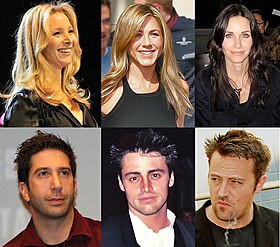Ensemble cast

In a dramatic production, an ensemble cast is one that comprises many principal actors and performers who are typically assigned roughly equal amounts of screen time.[2][3]
Structure
[edit]In contrast to the popular model, which gives precedence to a sole protagonist, an ensemble cast leans more towards a sense of "collectivity and community".[4]
Cinema
[edit]Ensemble casts in film were introduced as early as September 1916, with D. W. Griffith's silent epic film Intolerance, featuring four separate though parallel plots.[5] The film follows the lives of several characters over hundreds of years, across different cultures and time periods.[6] The unification of different plot lines and character arcs is a key characteristic of ensemble casting in film; whether it is a location, event, or an overarching theme that ties the film and characters together.[5]
Films that feature ensembles tend to emphasize the interconnectivity of the characters, even when the characters are strangers to one another.[7] The interconnectivity is often shown to the audience through examples of the "six degrees of separation" theory, and allows them to navigate through plot lines using cognitive mapping.[7] Examples of this method, where the six degrees of separation is evident in films with an ensemble cast, are in productions such as Love Actually, Crash, and Babel, which all have strong underlying themes interwoven within the plots that unify each film.[5] Whodunit films also often feature interconnected characters as suspects, such as in Death on the Nile, Clue, and Knives Out.[8]
The Avengers, X-Men, and Justice League are three examples of ensemble casts in the superhero genre.[9][10] Referential acting is a key factor in executing this balance, as ensemble cast members "play off each other rather than off reality".[4]
Filmmakers known for their use of ensemble casts include Quentin Tarantino, Wes Anderson, and Paul Thomas Anderson among others.
Television
[edit]Ensemble casting also became more popular in television series because it allows flexibility for writers to focus on different characters in different episodes. In addition, the departure of players is less disruptive than would be the case with a regularly structured cast. The television series The Golden Girls and Friends are archetypal examples of ensemble casts in American sitcoms. The science-fiction mystery drama Lost features an ensemble cast. Ensemble casts of 20 or more actors are common in soap operas, a genre that relies heavily on the character development of the ensemble.[11] The genre also requires continuous expansion of the cast as the series progresses, with soap operas such as General Hospital, Days of Our Lives, The Young and the Restless, and The Bold and the Beautiful staying on air for decades.[12]
An example of a success for television in ensemble casting is the Emmy Award-winning HBO series Game of Thrones. The fantasy series features one of the largest ensemble casts on the small screen.[13] The series is notorious for major character deaths, resulting in constant changes within the ensemble.[14]
Ensemble casts are common in children's television, with both human and non-human casts. Examples include The Muppets, Sesame Street, Foster's Home for Imaginary Friends, Rugrats, SpongeBob SquarePants, Total Drama, Animaniacs, Tiny Toon Adventures, and Freakazoid!, Cow and Chicken, Hey Arnold!, The Proud Familyand The Replacements.
See also
[edit]References
[edit]- ^ McCarroll, Christina (May 6, 2004). "A family sitcom for Gen X - Friends cast a new TV mold". The Christian Science Monitor. Archived from the original on January 31, 2009. Retrieved December 19, 2008.
- ^ Random House: ensemble acting Linked 2013-07-17
- ^ Steven Withrow; Alexander Danner (2007). Character design for graphic novels. Focal Press/Rotovision. p. 112. ISBN 9780240809021. Archived from the original on 2023-04-21. Retrieved 2009-09-05.
- ^ a b Mathijs, Ernest (March 1, 2011). "Referential acting and the ensemble cast". Screen. 52 (1): 89–96. doi:10.1093/screen/hjq063. Archived from the original on March 8, 2021. Retrieved June 15, 2020 – via academic.oup.com.
- ^ a b c "Ensemble Film, Postmodernity and Moral Mapping". www.screeningthepast.com. Archived from the original on 2018-08-13. Retrieved 2020-06-15.
- ^ "Intolerance (1916)". Filmsite. Archived from the original on 2019-10-29. Retrieved 2020-06-15.
- ^ a b Silvey, Vivien (June 5, 2009). "Not Just Ensemble Films: Six Degrees, Webs, Multiplexity and the Rise of Network Narratives". FORUM: University of Edinburgh Postgraduate Journal of Culture & the Arts (8). doi:10.2218/forum.08.621. S2CID 129196139. Archived from the original on April 24, 2021. Retrieved June 25, 2014 – via www.forumjournal.org.
- ^ Allen, Nick (2019-11-27). "13 Great Ensemble Whodunits to Watch After Knives Out". Vulture. Retrieved 2025-01-19.
- ^ Child, Ben (April 23, 2012). "Avengers Assemble disarms the critics". The Guardian. Archived from the original on November 11, 2018. Retrieved December 19, 2016 – via www.theguardian.com.
- ^ "Joss Whedon talks in depth about the ensemble cast of 'The Avengers'". www.hypable.com. November 19, 2011. Archived from the original on 2017-05-28. Retrieved 2020-06-15.
- ^ Ford, Sam (15 September 2008). "View of Soap operas and the history of fan discussion | Transformative Works and Cultures". Transformative Works and Cultures. 1. doi:10.3983/twc.2008.042. Archived from the original on 9 February 2022. Retrieved 15 June 2020.
- ^ "The Survival of Soap Opera (Part Two):The History and Legacy of Serialized Television". Henry Jenkins. 7 December 2010. Archived from the original on 2021-08-30. Retrieved 2020-06-15.
- ^ Campbell, Scott (June 10, 2014). "David Cameron: 'I'm a Game of Thrones fan'". Archived from the original on May 7, 2019. Retrieved April 5, 2018 – via www.telegraph.co.uk.
- ^ Brereton, Adam (June 12, 2013). "The Game of Thrones: Nobody wins, everybody dies". ABC Religion & Ethics. Archived from the original on January 11, 2019. Retrieved June 15, 2020.
